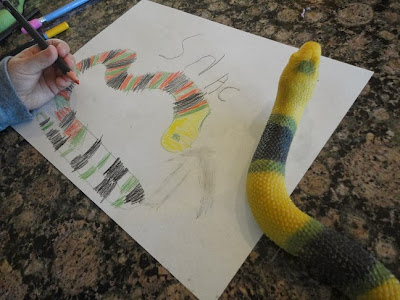The Geography worksheet the girls completed on the desert involved reading and pasting a description of a desert habitat and then identifying and pasting some of the animals that live in the desert. Any worksheet involving gluing is always a hit with my 4 year olds.
For reading comprehension, we read a section about deserts in their Houghton Mifflin First Grade Anthology. We enjoyed studying the different types of deserts and then looking them up on our inflatable globe to see where they are in the world.
The kids and I talked about the various animals that live in deserts and what adaptations they have for surviving the harsh conditions (this was also the topic of the Magic School Bus episode). Since the girls have been especially interested in snakes lately after picking out rubber snake toys when we went camping last month, I asked them if they wanted to draw snakes.
They both worked hard on filling in the patterns on their snakes, and then ended up playing with both their rubber and paper snakes in their rooms for quite a while. And, yes, I mentioned that different types of snakes live in different habitats - some live in moist climates like rainforests, and others like rattlesnakes live in dry climates.
Some animals in the desert never have to take a drink of water their entire lives because they get sufficient amounts of water from the food they eat. To determine if food really has water in it, we put a piece of cantaloupe in a Ziplock bag and placed it out in the sun on the deck for a couple hours. The girls then observed the results (water evaporated out of the fruit, condensed on the bag, and then collected in the corner of the bag when it dripped down). We might repeat this experiment at a later time to determine which foods have the highest water content.
My favorite activity was making this cute little cactus out of modeling clay. I helped the kids with the shape, and then they pushed in whole cloves for the spines. It smells wonderful!
Of course a couple days after we did our Desert Habitat mini-unit, I discovered a book on our bookshelf with even more activities for kids on various habitats - we'll have to revisit this and try some new crafts from that book next time. Overall, the kids learned a lot and had fun. Maybe we'll visit Utah or Arizona next year and they'll get to see a real desert in action.
If you want to keep up with the latest updates from Learners in Bloom, please follow us on:








Greetings! Looks like everyone had a great time learning about the desert! I'm Heather and I was hoping you could answer my question I have about your blog! My email is Lifesabanquet1(at)gmail(dot)com :-)
ReplyDelete